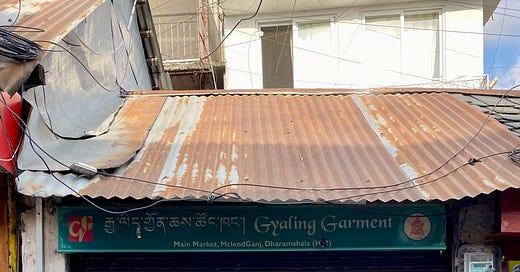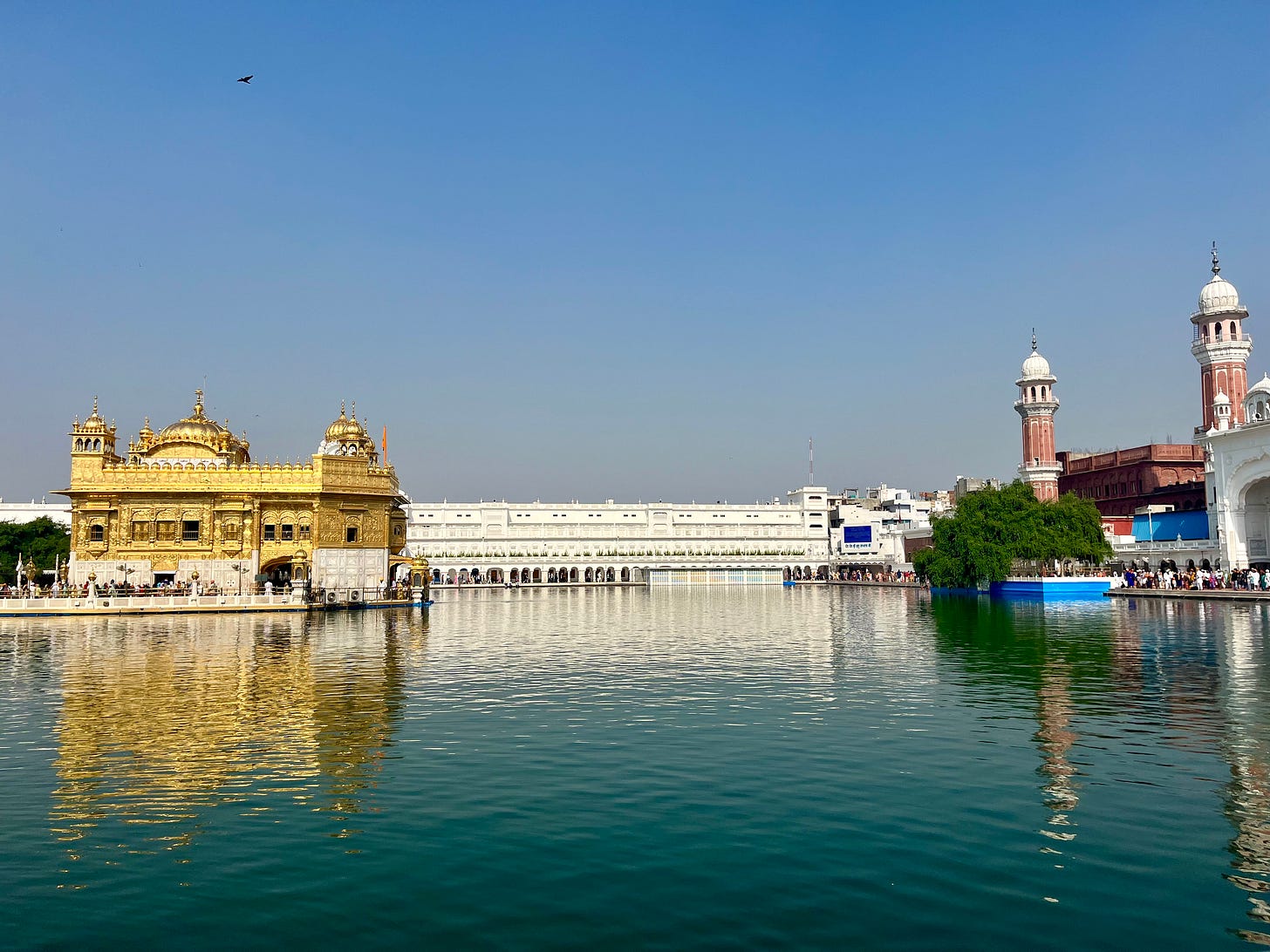Life on the road: can the rooftop of the world provide hope for humanity?
The Tibetan model might be the way for democracy to survive and thrive when under threat, if supported by the world! The alternative is pretty terrifying.
Dear Friends,
As the world continues to descend into darkness, I got a glimpse of hope from the Central Tibetan Administration, and I’m sure it can inspire you too.
After spending the week in Delhi,
and I packed up and headed to Dharamshala, in the North of India. This is where the Tibetan Government in Exile - formally known as the Central Tibetan Administration (CTA) - is headquartered. We went there hoping to understand better the inner workings of a government in exile, what the world can do to support and what a global political party like Atlas should know.Read on to learn about the occupation of Tibet, how the CTA can be a best practice for other freedom struggles, and for a take on how the United Nations is losing credibility daily regarding human rights and democracy.
🇮🇳 Destination: The Central Tibetan Administration (CTA) in Dharamshala
This past week with the Tibetan administration was simply incredible, humbling and mind-blowing. And no, I’m not exaggerating. I had the luck of interacting with Tibetan representatives in the past during some of Atlas’ campaigns and townhalls (you can watch this townhall with Tenzin Lekshay, Official Spokesperson of the Central Tibetan Administration, on whether the CTA can be the model for Hong Kong, and this townhall with Tashi Phuntsok on Tibet’s democracy ). I also did quite a bit of research on the CTA as its way of keeping the freedom struggle alive, providing representation, and innovating democracy fascinated me.
However, getting to be at the H.Q. of the CTA was just a whole other level: we witnessed the kindness and patience of representatives willing to walk us through the history of Tibet, understood better how the CTA functions, and talked through what we can all do to support Tibet.
But not only. The focus of civil society, the government and the Tibetans we met was not only Tibet but humanity’s well-being. From experience, when your freedom is at stake, you often focus only on your struggle. It’s understandable, but it also makes alliances difficult and progress slower. Tibetans are definitely one-of-a-kind.
Wait, what happened in Tibet?
Let’s start with Tibet. Just like the history of any nation, it’s messy and entangled. You can find detailed timelines here and here, but let me summarize some key facts relevant to today’s occupation by China:
Tibet is an ancient nation with a recorded history dating back to 127 B.C. Its empire reached its peak in the 7th/8th centuries.
There was then a period of rule by the Mongols in the 13th century.
Tibet was then independent from the 14th to 18th century, first under Tibetan ruling houses, and then under the Ganden government created by the Fifth Dalai Lama.
In 1904, the British invaded Tibet.
From 1912 to 1951, Tibet was again de facto independent.
In 1949 and 1950, the Chinese army invaded the eastern provinces of Amdo and Kham.
In 1951, the Chinese government marched into the Tibetan capital of Lhasa. Resistance to the Chinese occupation escalated, particularly in eastern Tibet, and Chinese repression increased dramatically.
By 1959, popular uprisings led to a massacre of Tibetans in Lhasa. The Dalai Lama was forced to flee to India, and so were over 100,000 people since then.
Since the invasion, an estimated 1.2 million Tibetans have been killed as a result of the Chinese occupation.
The Dalai Lama established a democratic government-in-exile in Dharamsala, India.
Now, let’s say it clearly: Tibet was an independent country, contrary to what the Chinese Communist Party is trying to assert. It had a passport as late as 1949, its own currency, and was invited to countries’ summits as a … country! Tibet is under occupation.
Tibet is also the biggest prison in the world. Listing China’s crimes in one post would take more than the entire length that substacks allow for, but consider that Freedom House ranked Tibet the least free country in the world, tying with South Sudan and Syria. As the International Campaign for Tibet explains, “Under Chinese rule, Tibetans are persecuted simply for preserving their cultural identity and most basic rights. They can be jailed and tortured just for celebrating the Dalai Lama’s birthday. And they face immense restrictions on their abilities to practice their religion, travel and speak freely.”
Okay, why in India?
When the Dalai Lama had to go into exile, he headed to India and had the foresight to plan for the long term, despite the fact that most hoped to return to Tibet within a couple of months. He bought land and established a government in exile to represent Tibetans at home and in exile, provide support and services, and work to achieve freedom in Tibet.
(see below a video a Tibetans welcoming the Dalai Lama home after a trip)
India was to become the home of those forced into exile. The Indian government was incredibly welcoming, providing a safe haven, settlements and funds. It, however, refrained from clear international support, probably due to its security concerns with its neighbour, China, and trade interests.
Tibetans we met were immensely grateful to India for welcoming them. They, however, face some issues:
the fact that India doesn’t support Tibet at the United Nations means that other countries are less likely to do so. The world looks to India as the host country of the Dalai Lama and the CTA when talking about Tibet’s occupation and status. India’s silence gives an excuse for others to say … nothing.
Tibetans in exile face practical issues in India. India is not a signatory to the Refugee Convention, making Tibetans stateless people. It means they have no nationality and can’t access the Indian one even if born in India, have no permanent residency and are thus way more vulnerable. This makes it very hard for them to find decent work, travel, and truly build a life where they are.
A government in exile, what does it do?
The CTA has two main missions (I’m paraphrasing): 1) restoring freedom to Tibet, 2) taking care of people in the meantime. It is structured as any traditional government with 3 independent branches but will be dissolved once freedom is established in Tibet to enable Tibetans there to decide their model of governance.
Here are some interesting facts:
Something that has also caught my attention was how the Dalai Lama democratised it: first through parliament, then through the executive power. You can read more about it here.
Since Tibetans can’t access their nationality, they have a “green book”: a document asserting their claim to a Tibetan nationality that they get after paying a voluntary tax.
The CTA experiments with democracy: instead of continuing to operate as a highly centralised government, it enables local experiments. For example, I was told that in settlements with 500 or more people, they can create their own local assemblies and elect a welfare officer.
What do Tibetans want?
While in Dharmashala,
and I met with:Speaker Khenpo Sonam Tenphel and Deputy Speaker Dolma Tsering of the Tibetan Parliament in Exile.
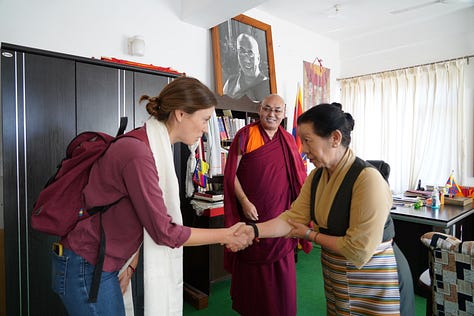
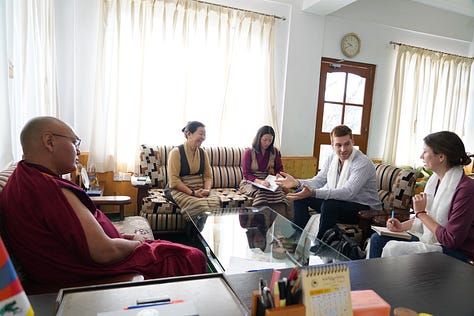
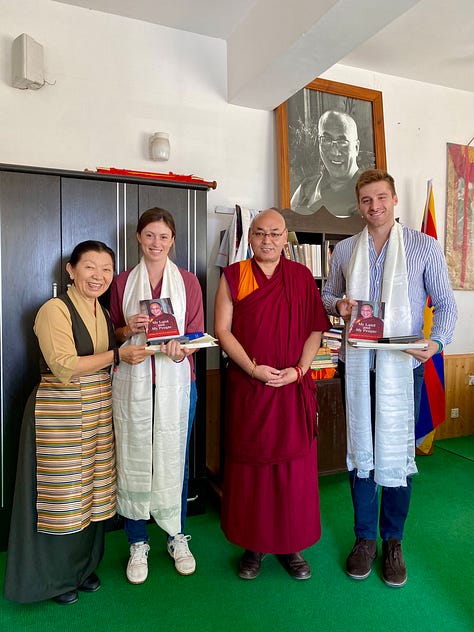
Tenzin Lekshay, Spokesperson of the CTA
many civil society groups, including the Tibetan Youth Congress, the Tibetan Women's Association, the International Tibet Network, the Tibet Policy Institute and the Tibetan Centre for Human Rights and Democracy.
Visited the Tibetan Medical and Astrological Institute, the Library of Tibetan Works and Archives, the Tibet Museum


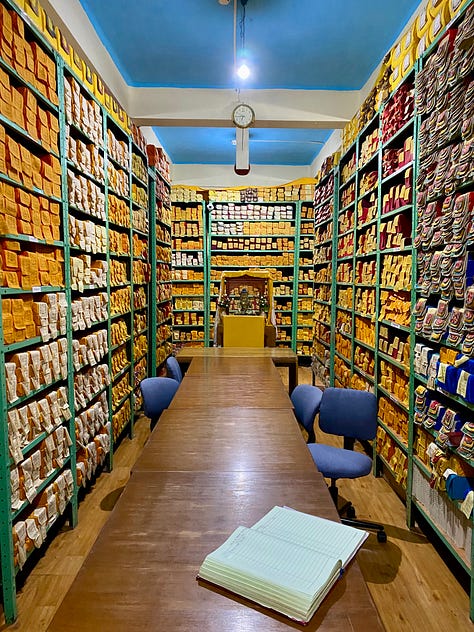
We went to understand better how the world should act, and what we should do. To give you an idea of how countries respond to Tibet's freedom struggle, ahead of the G20 in India, the Speaker of the Parliament sent a letter to G20 delegations - that you can read here - outlining clear demands for Tibetans and the world. Countries largely ignored it.
And what the CTA is asking for is pretty basic:
a recognition of the occupation,
Early on, debates happened on whether to advocate for full independence or autonomy. As I was told, it’s only legitimate for Tibetans to want independence and hope for it, but it’s not practical. That’s why the CTA wants autonomy to safeguard Tibet’s culture, religion and people.
When talking about Tibet’s hope to end the occupation, officials point to the middle way policy, which “means to achieve a genuine autonomy for all Tibetans living in the three traditional provinces of Tibet within the framework of the People's Republic of China. This is called the Middle-Way Approach, a non-partisan and moderate position that safeguards the vital interests of all concerned parties - for Tibetans: the protection and preservation of their culture, religion and national identity; for the Chinese: the security and territorial integrity of the motherland; and for neighbours and other third parties: peaceful borders and international relations.”
That’s not to say that everyone agrees. groups demand loudly and clearly the independence of Tibet.
support to preserve culture & education, and
The CCP brutally cracks down on culture and education in Tibet. As mentioned, the very act of preserving one’s identity can be criminal and have large repercussions. The CTA wants to provide key cultural and educational services to ensure the survival of Tibet.
action to protect the Tibetan plateau it's
the world's highest and largest plateau above sea level and has more than 46,000 glaciers.)
As the Deputy Speaker told us: “Tibet is the roof of the world, but what happens when the roof starts leaking?” She went on to explain that this last demand is the most important one: the environment concerns all of humanity and would have a dramatic impact on all beings, not just Tibetans. "That's more important than only one struggle.”
Through other meetings, we gathered other practical demands to push forward. One that particularly struck me was the need to support victims of transnational repression. That’s a topic that came up a lot in our work at Atlas on Hong Kong: the Chinese Communist Party has a unique ability to act illegally and terrorise (if not worse) dissidents and critics abroad in an attempt to silence and control them. From harassment to threats against their family or the establishment of overseas police stations, the CCP reaches way beyond China’s borders. And it is happening to Tibetans, a lot. An easy support all governments should put in place is a hotline to report acts of transnational repression and seek help.
The CTA, a model for other freedom struggles?
The model of the CTA is incredibly interesting. While it was emphasised on a very regular basis that the kinship and unity of the Tibetan people is due to the Dalai Lama, who provided guidance, decided to renounce power for democracy to prevail and still represents the spirit of Tibet, it can still be of great inspiration to other freedom struggles. Even if they don't have their Dalai Lama.
Hear me out: freedom struggles often last decades, if not longer (it's been 64 years of occupation for Tibet and 56 for Palestine). As Nelson Mandela said, “There is no easy walk to freedom anywhere, and many of us will have to pass through the valley of the shadow of death again and again before we reach the mountaintop of our desires.” This means that those working to end oppression and to regain access to their rights and freedoms are often delegitimised, ignored, and split themselves into factions and more. It is also hard for them to stay at the service of their people while fighting such big struggles. A Government in Exile provides some answers to those issues:
some people hold clear legitimacy to represent the interest of a group in front of the international community, and
through regular elections, they continue to represent their people and can best support them.
Obviously, it doesn't apply to all struggles equally. As I was told, for a government in exile to succeed:
most groups involved in the struggle must find a minimum common denominator behind which to rally and then build from there. Otherwise, such a government cannot be taken seriously. This means egos must be put aside and ideological differences ignored for a while.
it needs to be big enough for it to function properly. this is obviously difficult for many freedom struggles that have a hard time securing financing for their basic needs, let alone a government in exile.
What now?
I wrote this blog to let you know some of what I learned during my week with the Tibetan Government in Exile. There is still a lot to unpack, this is just the beginning.
At Atlas, we will now formulate policy on Tibet and other freedom struggles so that our future elected officials stand by those working for freedom,
We will host events and create partnerships to advance the Tibetan topic worldwide, and
more! Send me your ideas!
📣Let's talk about global politics: the U.N.'s (il)legitimacy on Human Rights
Despite occupying Tibet, committing the crime of genocide against Uyghurs, crackdowns in Hong Kong, and constantly threatening Taiwan, China was re-elected to the United Nations Human Rights Council.
Hear from Gonpo Dhundup from the Tibetan Youth Congress about this:
And yes, the U.N. Human Rights Council's mission is “to promote and protect human rights around the world.” Shame on the 154 who voted for China (it's by secret ballot, so I unfortunately can’t name and shame)! It's insane, disgusting, and a shame on humanity and the U.N.: how can a country guilty of crimes of genocide, occupation, and more be elected to the U.N. Human Rights Council?!
The rare silver lining is that Russia wasn't elected. However, the fact that it was even a question and that China was elected, alongside other authoritarian countries like Cuba, is simply insane and makes a mockery of the United Nations. As we wrote in our political philosophy - the Philosophy of Unity - the United Nations is simply outdated when it comes to protecting rights and democracy. That's why we must work to organise an alternative global alliance for democracies only to protect, promote, and innovate democracy worldwide. Learn more about it here.
💫 Next up: Amritsar
In my next newsletter, I'll tell you about Amritsar, the capital of the Sikh religion that is home to:
the Golden Temple distributing 100,000 free meals a day to anyone who needs it, and
the partition museum that explains and brings stories of the partition of India and Pakistan.
Let me know what you think, send me your feedback and ideas, and don’t forget to take action to unite the world.
One way is to join or donate to Atlas, the global political party uniting people worldwide to create a freer, better and more equitable world (click here)!
Cheers,
Colombe

